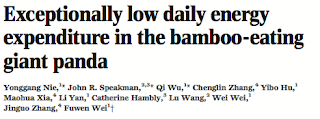Most papers published in Science attract media attention. A number of articles picked up the story of studies on the metabolic rate of the Giant Panda (Ailuropoda melanoleuca) which confirm what has been long suspected—it is a ‘slow’ mammal in that its metabolic rate is much lower than expected for an animal of its body weight. Daily energy expenditure was, in five captive and three wild panda, only 38% of that predicted from a modern version of the ‘mouse to elephant’ line in a log-log plot.
 |
| Science 2015 349, 171-174 |
The Giant Panda is a bear equipped with a short digestive tract, typical of the carnivores, that eats pretty well only bamboo, a diet that would even give a herbivore a problem. The efficiency of digestion is, therefore, low and the panda must feed for many hours a day and consume large quantities of bamboo. Even then, as the latest work confirms, a low metabolic rate is a key adaptation of this species that enables energy balance to be achieved.
In part the low metabolic rate can be accounted for by relatively low levels of activity and speed of movement compared with other bears. However, what I found particularly intriguing is the manner in which resting metabolic rate is kept low. Organs of high energy demand—brain, liver and kidneys—were found to be relatively small but there must be a generally low basal metabolic rate in each tissue. In his connexion it was found that plasma or serum concentrations (which is not stated) of thyroid hormones (thyroxine and triiodothyronine) of captive pandas were also low. So the Giant Panda seems to be using a conventional control of metabolic rate by thyroid hormones. The authors then went on to compare the genome of the panda with that of other mammals in terms of genes controlling thyroid hormone signalling and synthesis. One apparently key difference was found: a unique variant of the DUOX2 gene which would appear to lead to loss of function. This gene is involved in the final step of thyroid hormone synthesis and in mice and man, loss-of-function mutations lead to hypothyroidism. However, this is where I see both a problem and a possibly incomplete explanation.
Loss of function of DUOX2 has been shown to have severe effects on a wide range of functions in addition to to virtually preventing the production of thyroid hormones. But even if the variant found in the panda were shown to have an incomplete loss of function that cannot be the entire explanation for the maintenance of low concentrations in plasma. If the pituitary-thyroid axis were operating as in a ‘normal’ mammal, the low thyroid hormone concentrations in plasma would lead to an increase in TSH from the pituitary with growth of the thyroid until sufficient thyroid hormone had been produced to reduce TSH production by negative feedback. In short, unless the plasma concentration at which TSH production is suppressed is lower in the panda, it matters not at all whether or not the synthesis of thyroid hormones is partially impaired.
No comments:
Post a Comment